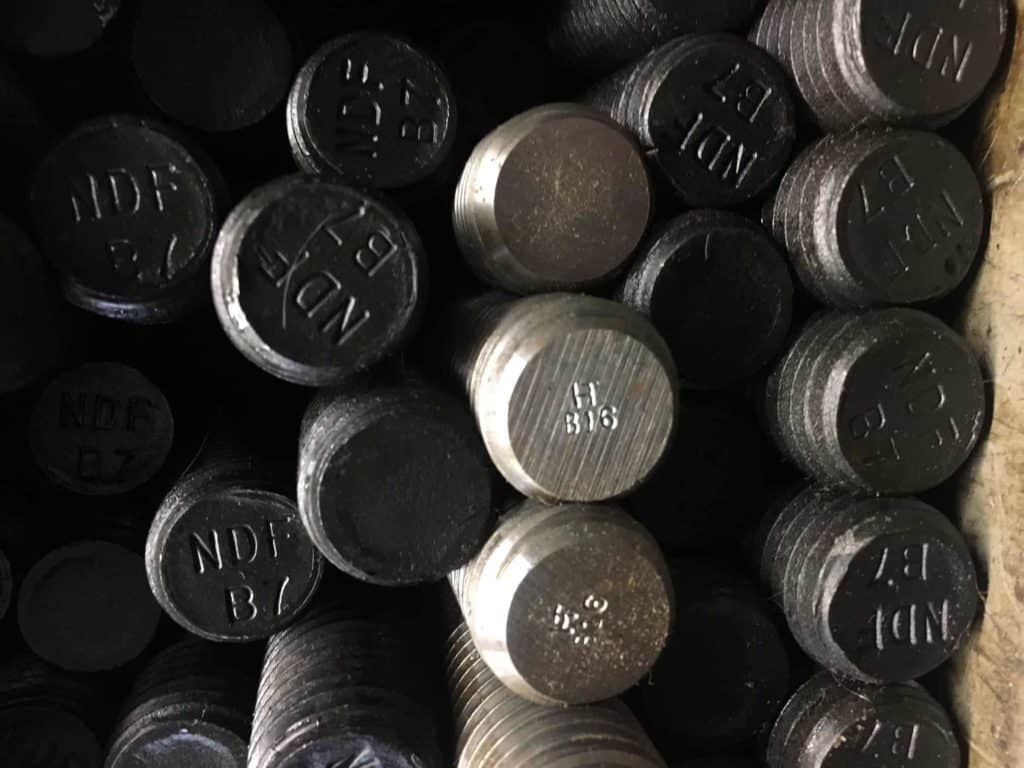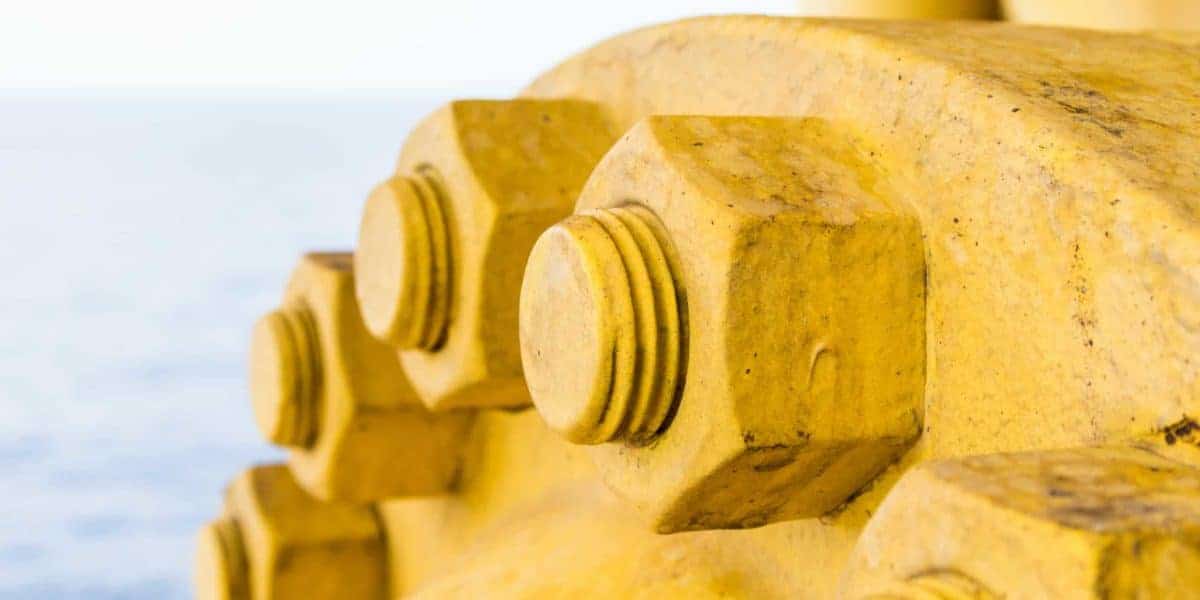At first glance, the names of fasteners used in bolting for ASME pressure vessels and piping can sound like something out of the old-school board game “Battleship.”
B7, B8, 2H, A193..dangit, you just sunk my destroyer.
Each of these labels are meaningful, and can indicate the use of different materials (such as alloy steel or stainless steel) with different mechanical properties.
The names also indicate which will perform better in certain environments, such as high-temperature and high-pressure applications.
In this article, we’ll discuss several different relevant aspects of these fasteners, including:
- tensile strength
- stainless steel (grade B8) vs. carbon steel (grade B7 & B16)
- heavy hex nuts (2H nuts, or Grade 4 & 7 nuts)
But we’ll start with an overview of the standards governing the use of nuts and bolts in industrial applications.
Summary of Standards for Common Fasteners
Industrial fasteners can be called stud bolts or — of course — just plain ol’ bolts. They are governed by three main industry standards:
- ASTM A193: “This specification covers alloy steel and stainless steel bolting material for pressure vessels, valves, flanges, and fittings for high temperature or high-pressure service, or other special-purpose applications. Ferritic steels shall be properly heat treated as best suits the high-temperature characteristics of each grade.”
- ASTM A320: “This specification covers alloy steel bolting materials and bolting components for pressure vessels, valves, flanges, and fittings for low-temperature service.”
- ASTM A194: “This specification covers a variety of carbon, alloy, and martensitic and austenitic stainless steel nuts. These nuts are intended for high-pressure or high-temperature service, or both.”
NOTE: Items that we will not cover in this article include: coating practices such as zinc plated, PTFE or Xylan(R) coating, hex bolts, or hex cap screws or machine screw nuts and coupling nuts found in ASME B18.2.2, as these have nothing to do with industrial bolting.
Stud and Nut Combinations
B7 Studs and 2H Nuts
ASTM A193 Grade B7 bolts are made of chromium-molybdenum steel. The bolts are quenched and tempered (a.k.a heat treated) to develop the desired tensile strength (mechanical properties).
Grade B7 Stud Bolts are used in pressure vessels that do not need corrosion resistance, aren’t susceptible to stress corrosion cracking, and for temperatures typically less than 750F. However, these bolts can have many different types of finishes, including:
- plain finish for standard applications
- hot-dip galvanized process
- zinc plated and/or have a PTFE or Xylan coating for corrosion resistance
NOTE: Typically a coated stud will have a lower temperature rating than plain finish stud bolts. (See our article “PTFE Coated Studs: Do They Work?” for more.)
Size and strength:
- ASTM A193 B7 stud bolts with a diameter of 2.5 inches or less will have a yield strength of 105,000 PSI.
- Grade B7 fasteners with a stud diameter of 2-5/8″ to 4″ diameter have a lower yield strength of 95,000 PSI.
- 4″ to 7″ inch stud bolts have an even lower yield strength of 75,000 PSI.
The nut material for Grade B7 bolts is typically ASTM A194 heavy hex nuts (2H nuts).

A194 Grade 2H Nuts
2H nuts work in combination with B7 Studs and are stronger than the stud bolt. Therefore you should see failure on the stud before you see failure in the nut.
NOTE: This does not include over tapping of the nut for coated materials as it would change the strength of the nut.
2H nuts, also known as Heavy Hex Nuts, are very common in the industry and easy to procure.
Grade B7M Studs and Nuts
ASTM A193 Grade B7M studs are identical in chemistry to Grade B7, as they are quenched and tempered carbon steel to achieve a lower hardness. However, they have a lower tensile strength than B7 studs.
We typically see Grade B7M bolts in hydrogen stress corrosion cracking (SCC) applications such as hydrofluoric acid or in Floating Head Heat Exchangers.
ASTM A194 GRADE 2HM are similar to 2H nuts, except this grade is recommended for use in stress corrosion cracking environments.
Grade B16 Studs
ASTM A193 B16 stud bolts are used primarily for high temperature applications of 751-1100F. They are manufactured from a chromium-molybdenum-vanadium alloy steel,
Although A193 Grade B16 bolts and studs have similar strength requirements as Grade B7, the fasteners retain strength under high temperatures, and also experience less relaxation at those high temperatures.
There are two nut combinations you can use for B16 stud bolts. They are:
- ASTM A194 GRADE 7: These are also heat-treated chrome-molybdenum steel nuts that are also suitable for sub-zero service conditions and have minimum Charpy impact values in accordance with ASTM specifications.
- ASTM A194 GRADE 4: These were taken out of ASTM A194 in 2017, but were heat treated molybdenum steel nuts.
It is imperative that you use Grade 7 (or 4) nuts with B16 studs, because they have similar properties. 2H Nuts, on the other hand, will relax more. So if you have high temperature and 2H nuts you will see increased relaxation, or loss of bolt load. (Not sure how to handle bolt relaxation? Contact us. We can help.)
B8 Studs Class 1 and Class 2: What’s the Difference?
ASTM A193 B8 studs are commonly used in high temperature applications (roughly 1101F to 1500F) . However, you have to be cautious because there is a difference between B8 Class 1 and B8 Class 2 studs.
Grade B8 stud bolts are made of AISI 304 stainless steel. These type of fasteners are made with austenitic stainless steel and require carbide solution treatment.
The carbide solution treatment, also known as solution annealing, is the process in which fasteners are heated and then water-quenched to assure maximum corrosion resistance.
Class 1 stud bolts are not strain-hardened, and have a yield strength of 30 KSI, or 30,000 PSI. However, Class 2 stud bolts are strain-hardened and have a 95,000 PSI or 95 KSI yield strength.
How can you tell a Class 2 versus a Class 1 bolt? The B8 symbol on a Class 2 will have a line underneath it, while a Class 1 will not have an underline. Please look for the line on a B8 class 2.
ASTM A194 GRADE 8 Stainless steel nuts required for these fasteners.
B8M Studs
ASTM A193 Grade B8M fasteners are manufactured the same way as B8 fasteners. The difference is in the materials that they are made of.
B8M fasteners are manufactured from AISI 316 stainless steel as opposed to AISI 304 stainless steel. The 316 form of stainless steel is better for corrosion resistance because it has more molybdenum.
ASTM A193 Grade B8M Class 1 fasteners require a carbide solution treatment, while Class 2 fasteners require an additional strain hardening just like B8 fasteners.
ASTM A194 GRADE 8M Stainless steel nuts are required for these fasteners.
ASTM A320, Grade L7 and Grade L7M
ASTM A320 Grade L7 and L7M fasteners are recommended for use in low temperature environments typically found to be -50F to -150F. These fasteners also require Grade 4 or Grade 7 nuts.
RELATED:
Beyond ASME PCC-1: What Today’s Bolting Professionals Need to Know
A Guide to Bolt Lubricant and Torque
Join Industry Leaders!
Subscribe to Hex Technology today and we’ll give you $700 in bolting courses, FREE. Your path to a safer, more reliable, more profitable site starts here.


